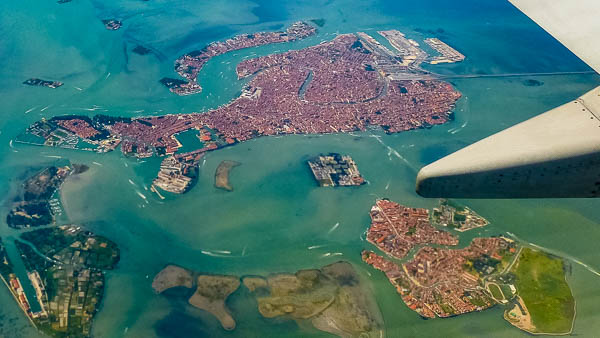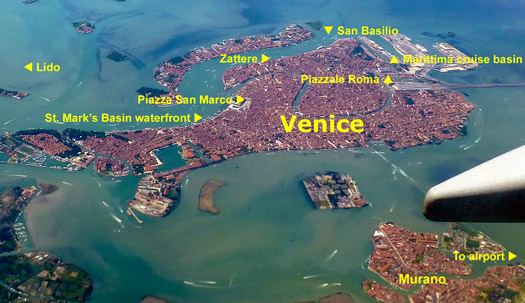Venice > Planning > Introducing Venice
Introducing Venice
An orientation for first-time visitors

ABOVE: An aerial view of Venice, Italy. The
city's historic center is in the upper half of the photo, with the
glassmaking island of Murano at
lower right.
By Durant
Imboden
Are you planning your
first trip to Venice, Italy? If so, this brief introductory guide will make
your task easier.
| Important:
The city of Venice has
introduced an "Access Fee" for day tourists on busy days during
high season. Visitors who stay overnight in the city's historic center or mainland
districts are exempt but must register before arrival.
Read our "Access Fee"
article for details. |
Basic geography
As you can see from the photo above, Venice
is an island city: The centro storico or historic center is a
tightly-integrated cluster of 118 small islands that are linked by more than 400
footbridges. (Every time you cross a canal, you're stepping onto another
island.) See "Is Venice
connected to the mainland?" for more details and aerial photos.
The entire city center covers only about 1,800 acres or
725 hectares, which is a little more than twice the size of New York's Central
Park or London's Hampstead Heath.
The centro storico or historic center of
Venice is connected
to the mainland suburb of Mestre by the
Ponte
della Libertà, a long causeway that was built early in the 19th Century.
 The
causeway carries road traffic to Venice's Piazzale
Roma and the parking island of
Tronchetto. Train tracks run alongside the roadway and end at the
Venezia Santa Lucia railroad station,
which is visible as a grey spot where the road curves toward Tronchetto.
The
causeway carries road traffic to Venice's Piazzale
Roma and the parking island of
Tronchetto. Train tracks run alongside the roadway and end at the
Venezia Santa Lucia railroad station,
which is visible as a grey spot where the road curves toward Tronchetto.
 Important islands near the historic center are La Giudecca (separated from the
centro storico by the Giudecca Canal, which is used by
Venice-Lido car ferries and small cruise ships),
San Michele (Venice's island cemetery), and
the glassmaking island of Murano.
Important islands near the historic center are La Giudecca (separated from the
centro storico by the Giudecca Canal, which is used by
Venice-Lido car ferries and small cruise ships),
San Michele (Venice's island cemetery), and
the glassmaking island of Murano.
To the right or east of the historic center is the
Lido di
Venezia, a long, narrow strip of land that separates the
Venetian Lagoon (which surrounds Venice) from
the Adriatic Sea.
In our "Picking the best hotel
location"
article, we make a statement that's worth repeating here:
Many first-time visitors book hotels (or let their travel agents
book hotels) without giving any thought to location. This can lead to
frustrating and expensive mistakes.
To see why, let's look at another aerial photo:

Let's say that you're arriving by air and spending two days in
Venice before departing on a small cruise ship from the San Basilio pier.
Your travel
agent books you into a hotel in Castello, inland from the Piazza San Marco. You're traveling with large, heavy
luggage.
Because your travel agent knows a lot about cruising but very
little about Venice, she didn't realize that:
-
You'll need to walk over a series of bridges and down
narrow, crowded streets with your bulky luggage to reach the hotel from the
San Marco airport-boat stop, and...
-
On the day of your cruise departure, you'll need to lug your
suitcases to a distant vaporetto pier where you can catch an
expensive water bus to San Basilio, or--alternatively--pay 60 or 70 euros
for a private water taxi.
You're going to have a frustrating experience that could have
been avoided if you'd stayed at a hotel closer to your cruise terminal.
The same principle applies if you're arriving and departing by
train: By staying within walking distance of the Santa Lucia railroad station,
you'll save time, hassle, and money.
To find suitable hotels quickly and easily, see our
Venice Hotel, B&B, and Apartments Guide.
Venice Transportation

ABOVE: This photo, taken from the Ponte dei
Scalzi bridge, shows two ACTV
vaporetti (water buses) on the Grand Canal. The Ferrovia ACTV
piers and the Santa Lucia Railway Station
are visible on the right, behind the boats and the Scalzi Church.
Arriving:
In our "Arriving in Venice"
article, we tell you how to reach the city center from the Venice Marco Polo and
Treviso airports, from the Mestre and Santa Lucia railroad stations, from the
cruise and ferry terminals, or by car.
If you're driving, you'll also want to see "Parking
in Venice," which has advice (with Web links) about where to park in Venice
or on the mainland.
Also see our Venice for Cruisers
section if you're arriving or departing on a cruise ship.
Getting around the city:
Our Local
Transportation Index lists articles about water buses (vaporetti),
water taxis, pedestrian and car ferries, tourist travel cards, and related
topics.
Most of the time, you won't need to use water buses or other
boats unless you have limited mobility or you're traveling to an island such as
Murano, Burano, or Torcello. What you will need is a good map, either
in print or on your phone.
Also see "Walking in
Venice," which has tips about directional
signs, street signs, and addresses.

More about Venice, Italy
After you've read this introduction to Venice, go to our
Venice Travel Guide, which lists all of our Venice
travel articles by category.
Finally, don't miss our Venice Frequently
Asked Questions (FAQ) section, which offers useful advice in an
easy-to-read format.
About the author:
 Durant Imboden has
written about Venice, Italy since 1996.
He covered Venice and European travel at About.com for 4-1/2 years before launching
Europe for Visitors (including
Venice for Visitors) with Cheryl
Imboden in 2001.
Durant Imboden has
written about Venice, Italy since 1996.
He covered Venice and European travel at About.com for 4-1/2 years before launching
Europe for Visitors (including
Venice for Visitors) with Cheryl
Imboden in 2001.
PC Magazine has called this "the premier visitors'
site for Venice, Italy." Over the years, it has helped more than 30 million
travelers. For more information, see About our site,
our Europe for Visitors
press clippings,
and
our reader testimonials.